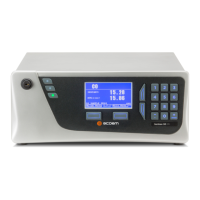TÜV Rheinland Energie und Umwelt GmbH
Luftreinhaltung
Report on the performance testing of the Serinus 30 ambient air quality moni-
toring system manufactured by Ecotech Pty Ltd measuring CO, Report no.:
936/21221977/D_EN
EP_Ecotech_Serinus30_en.docx
7.1 8.4.12 Averaging test
The averaging effect shall not exceed 7 % of the instrument reading.
7.2 Test procedure
The averaging test gives a measure of the uncertainty in the averaged values caused by
short-term concentration variations in the sampled air shorter than the time scale of the
measurement process in the analyser. In general, the output of an analyser is a result of the
determination of a reference concentration (normally zero) and the actual concentration
which takes a certain time.
For the determination of the uncertainty due to the averaging, the following concentrations
are applied to the analyser and readings are taken at each concentration:
- a stepwise varied concentration of CO between zero; and
- a concentration c
t
similar to the 8-hour limit value (8.6 µmol/mol).
The time period (t
c
) of the constant CO concentration shall be at least equal to a period nec-
essary to obtain four independent readings (which is equal to at least sixteen response
times). The time period (t
v
) of the varying CO concentration shall be at least equal to a period
to obtain four independent readings. The time period (t
CO
) for the CO concentration shall be
45 s followed by a period (t
zero
) of 45 s zero concentration. Further:
c
t
is the test gas concentration, in µmol/mol;
t
v
is the total number of t
CO
- and t
zero
pairs, and contains a minimum of three such pairs, in
s.
The change from t
CO
to t
zero
shall be within 0.5 s. The change from t
c
to t
v
shall be within one
response time of the analyser under test.
The averaging effect (E
av
) is calculated according to:
100*
2
var
av
const
avav
const
av
C
CC
E
−
=
where
is the averaging effect (in %);
is the average of the at least four independent measurements during the constant
concentration period (t
c
), in µmol/mol;
is the average of the at least four independent measurements during the variable
concentration period (t
v
), in µmol/mol.

